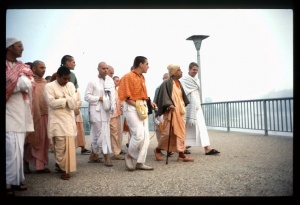CC Madhya 9.178: Difference between revisions
m (1 revision(s)) |
No edit summary |
||
| Line 1: | Line 1: | ||
{{ | [[Category:Sri Caitanya-caritamrta - Madhya-lila Chapter 09|C178]] | ||
<div style="float:left">'''[[Sri Caitanya-caritamrta|Śrī Caitanya-caritāmṛta]] - [[CC Madhya|Madhya-līlā]] - [[CC Madhya 9|Chapter 9: Lord Śrī Caitanya Mahāprabhu's Travels to the Holy Places]]'''</div> | |||
<div style="float:right">[[File:Go-previous.png|link=CC Madhya 9.177|Madhya-līlā 9.177]] '''[[CC Madhya 9.177|Madhya-līlā 9.177]] - [[CC Madhya 9.179|Madhya-līlā 9.179]]''' [[File:Go-next.png|link=CC Madhya 9.179|Madhya-līlā 9.179]]</div> | |||
{{CompareVersions|CC|Madhya 9.178|CC 1975|CC 1996}} | |||
{{RandomImage}} | |||
==== TEXT 178 ==== | ==== TEXT 178 ==== | ||
<div | <div class="verse"> | ||
dakṣiṇa-mathurā āilā kāmakoṣṭhī haite | :dakṣiṇa-mathurā āilā kāmakoṣṭhī haite | ||
tāhāṅ dekhā haila eka brāhmaṇa-sahite | :tāhāṅ dekhā haila eka brāhmaṇa-sahite | ||
</div> | </div> | ||
| Line 12: | Line 16: | ||
==== SYNONYMS ==== | ==== SYNONYMS ==== | ||
<div | <div class="synonyms"> | ||
dakṣiṇa- | ''dakṣiṇa-mathurā''—at southern Mathurā; ''āilā''—arrived; ''kāmakoṣṭhī haite''—from Kāmakoṣṭhī; ''tāhāṅ''—there; ''dekhā haila''—He met; ''eka''—one; ''brāhmaṇa-sahite''—with a ''brāhmaṇa''. | ||
</div> | </div> | ||
| Line 19: | Line 23: | ||
==== TRANSLATION ==== | ==== TRANSLATION ==== | ||
<div | <div class="translation"> | ||
When Śrī Caitanya Mahāprabhu arrived at southern Mathurā from Kāmakoṣṭhī, He met a brāhmaṇa. | When Śrī Caitanya Mahāprabhu arrived at southern Mathurā from Kāmakoṣṭhī, He met a brāhmaṇa. | ||
</div> | </div> | ||
| Line 26: | Line 30: | ||
==== PURPORT ==== | ==== PURPORT ==== | ||
<div | <div class="purport"> | ||
Southern Mathurā, presently known as Madurai, is situated on the banks of the Bhāgāi River. This place of pilgrimage is specifically meant for the devotees of Lord Śiva; therefore it is called Śaiva-kṣetra, that is, the place where Lord Śiva is worshiped. In this area there are mountains and forests. There are also two Śiva temples, one known as Rāmeśvara and the other known as Sundareśvara. There is also a temple to Devī called the Mīnākṣī-devī temple, which displays very great architectural craftsmanship. It was built under the supervision of the kings of the Pāṇḍya Dynasty, and when the Muslims attacked this temple, as well as the temple of Sundareśvara, great damage was done. In the Christian year 1372, a king named Kampanna Udaiyara reigned on the throne of Madurai. Long ago, Emperor Kulaśekhara ruled this area, and during his reign he established a colony of brāhmaṇas. A well-known king named Anantaguṇa Pāṇḍya is an eleventh-generation descendant of Emperor Kulaśekhara. | Southern Mathurā, presently known as Madurai, is situated on the banks of the Bhāgāi River. This place of pilgrimage is specifically meant for the devotees of Lord Śiva; therefore it is called Śaiva-kṣetra, that is, the place where Lord Śiva is worshiped. In this area there are mountains and forests. There are also two Śiva temples, one known as Rāmeśvara and the other known as Sundareśvara. There is also a temple to Devī called the Mīnākṣī-devī temple, which displays very great architectural craftsmanship. It was built under the supervision of the kings of the Pāṇḍya Dynasty, and when the Muslims attacked this temple, as well as the temple of Sundareśvara, great damage was done. In the Christian year 1372, a king named Kampanna Udaiyara reigned on the throne of Madurai. Long ago, Emperor Kulaśekhara ruled this area, and during his reign he established a colony of ''brāhmaṇas''. A well-known king named Anantaguṇa Pāṇḍya is an eleventh-generation descendant of Emperor Kulaśekhara. | ||
</div> | </div> | ||
__NOTOC__ | |||
<div style="float:right; clear:both;">[[File:Go-previous.png|link=CC Madhya 9.177|Madhya-līlā 9.177]] '''[[CC Madhya 9.177|Madhya-līlā 9.177]] - [[CC Madhya 9.179|Madhya-līlā 9.179]]''' [[File:Go-next.png|link=CC Madhya 9.179|Madhya-līlā 9.179]]</div> | |||
__NOTOC__ | |||
__NOEDITSECTION__ | |||
Revision as of 11:14, 26 August 2021

A.C. Bhaktivedanta Swami Prabhupada
TEXT 178
- dakṣiṇa-mathurā āilā kāmakoṣṭhī haite
- tāhāṅ dekhā haila eka brāhmaṇa-sahite
SYNONYMS
dakṣiṇa-mathurā—at southern Mathurā; āilā—arrived; kāmakoṣṭhī haite—from Kāmakoṣṭhī; tāhāṅ—there; dekhā haila—He met; eka—one; brāhmaṇa-sahite—with a brāhmaṇa.
TRANSLATION
When Śrī Caitanya Mahāprabhu arrived at southern Mathurā from Kāmakoṣṭhī, He met a brāhmaṇa.
PURPORT
Southern Mathurā, presently known as Madurai, is situated on the banks of the Bhāgāi River. This place of pilgrimage is specifically meant for the devotees of Lord Śiva; therefore it is called Śaiva-kṣetra, that is, the place where Lord Śiva is worshiped. In this area there are mountains and forests. There are also two Śiva temples, one known as Rāmeśvara and the other known as Sundareśvara. There is also a temple to Devī called the Mīnākṣī-devī temple, which displays very great architectural craftsmanship. It was built under the supervision of the kings of the Pāṇḍya Dynasty, and when the Muslims attacked this temple, as well as the temple of Sundareśvara, great damage was done. In the Christian year 1372, a king named Kampanna Udaiyara reigned on the throne of Madurai. Long ago, Emperor Kulaśekhara ruled this area, and during his reign he established a colony of brāhmaṇas. A well-known king named Anantaguṇa Pāṇḍya is an eleventh-generation descendant of Emperor Kulaśekhara.